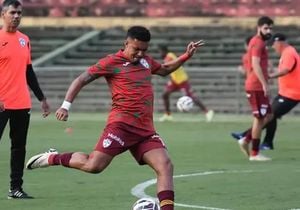PEBBLE BEACH, Calif. -- With increasing complaints about slow play at the PGA Tour events, officials announced Wednesday significant changes aimed at speeding up the pace of play and enhancing the viewing experience. The discussions came to the forefront during the lead-up to the AT&T Pebble Beach Pro-Am, where the Tour officials emphasized their commitment to adapting to modern demands.
“Everything’s on the table,” said Andy Weitz, PGA Tour’s chief marketing and communications officer, underlining the organization’s readiness for reforms driven by fan feedback. This engagement is informed by the Tour's Fan Forward initiative, which gathered insights from approximately 50,000 interviews across the golf community.
Among the changes proposed are the use of distance-measuring devices, which allow players and caddies to utilize rangefinders during tournaments. Although specifics about which events will trial these devices remain undisclosed, Commissioner Jay Monahan and other executives have indicated they plan to sample different tournament settings to assess the efficacy.
Further initiatives include publicizing pace-of-play statistics based on average stroke time, which reflects the time taken by players to hit each shot, and the potential for fines or penalties for slow play infractions. This level of transparency aims to hold players accountable and respond to fan frustrations.
The efforts to address the slow-play conundrum are not informal; the PGA Tour aims to leverage its newly opened video review center to expedite decision-making during games. Gary Young, senior vice president of rules and competitions, stated, “The goal is to create the best version of PGA Tour golf, ensuring we respect fans and fellow competitors.”
Fans recently voiced their concerns, most audibly during CBS broadcasts—analyst Dottie Pepper labeled situations like the players taking three hours to complete just nine holes during the Farmers Insurance Invitational as unacceptable. “We need to drastically improve the pace; it’s about respect for the sport and the fans,” she articulated.
Interestingly, statistics indicate the average stroke time has remained stable around 38 seconds for the past several years, but the Tour recognizes the perception and reality of slow play are increasing challenges. To this end, officials are also considering reducing the size of tournament fields, which is expected to alleviate congestion and improve the pace at specific events starting in 2026.
“The larger field sizes have often concealed slow players, but with reduced fields, it will be easier to identify issues like inconsistent pace,” Young noted, emphasizing the role of course setup, weather, and conditioning as other contributing factors to slow rounds.
“This is about changing player behavior” said Weitz, stressing the Tour seeks solutions not only to address slow play but also to evolve the game. To some extent, rays of hope are evident; players like Tyler Dennis, chief competitions officer, acknowledged, “Pace of play involves various factors—player behavior, timing, and technology.”
Traditionally, slow play has haunted the PGA Tour, with rounds frequently extending beyond five hours. Prompted by audience feedback, the Tour is even considering publicizing average times for individual players—a move intended to inform fans about who tends to take longer.
This line of thought shines light on the need for modern solutions. “We’re hearing consistently from fans—if using rangefinders can expedite play, why are we hesitating?” remarked Young, highlighting pressure from fans for the adoption of such technology already familiar to them.”
The tour’s experiments won’t stop with just rangefinders. There is also discussion around variances of tournament formats, especially for the Tour Championship, with potential changes to match-play brackets being speculated, giving tournament fans different scenarios to be excited about.
Commentators on the Tour have recently pointed out the need for more stringent enforcement of pace-of-play guidelines. Players themselves have started to take ownership of the issue, with many admitting their routines can lead to slower rounds than necessary. “We all understand the challenges slow play presents, and we want to work together to mitigate it,” said Young.
The PGA Tour recognizes there’s more work to be done, indicating changes could be finalized as soon as March. The organization hopes to create momentum and focus around improving the experience for viewers at home, as well as competitors on the green.
Changes to pace are not just seen as accommodating current broadcasting formats but as necessary evolution for golf, aiming to address fan concerns and uphold the integrity of the game. The PGA Tour must evolve without compromising its traditions.
With prominent players like Rory McIlroy acknowledging the slow-play issue and advocating for potential field size reductions, there’s mutual recognition among players and officials about the urgent need for progress.
Looking forward, the PGA Tour is poised on the brink of transformational changes as it addresses long-standing concerns surrounding slow play—a measure of respect for the game and its audience.



